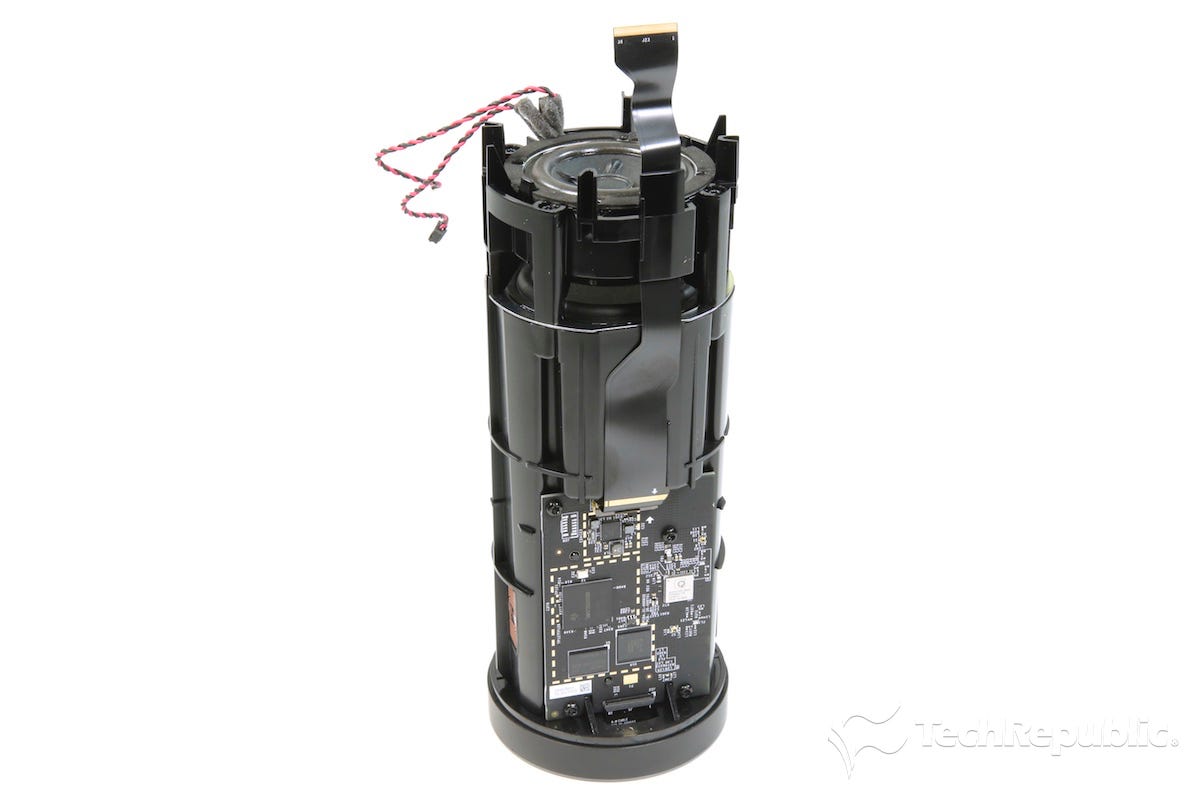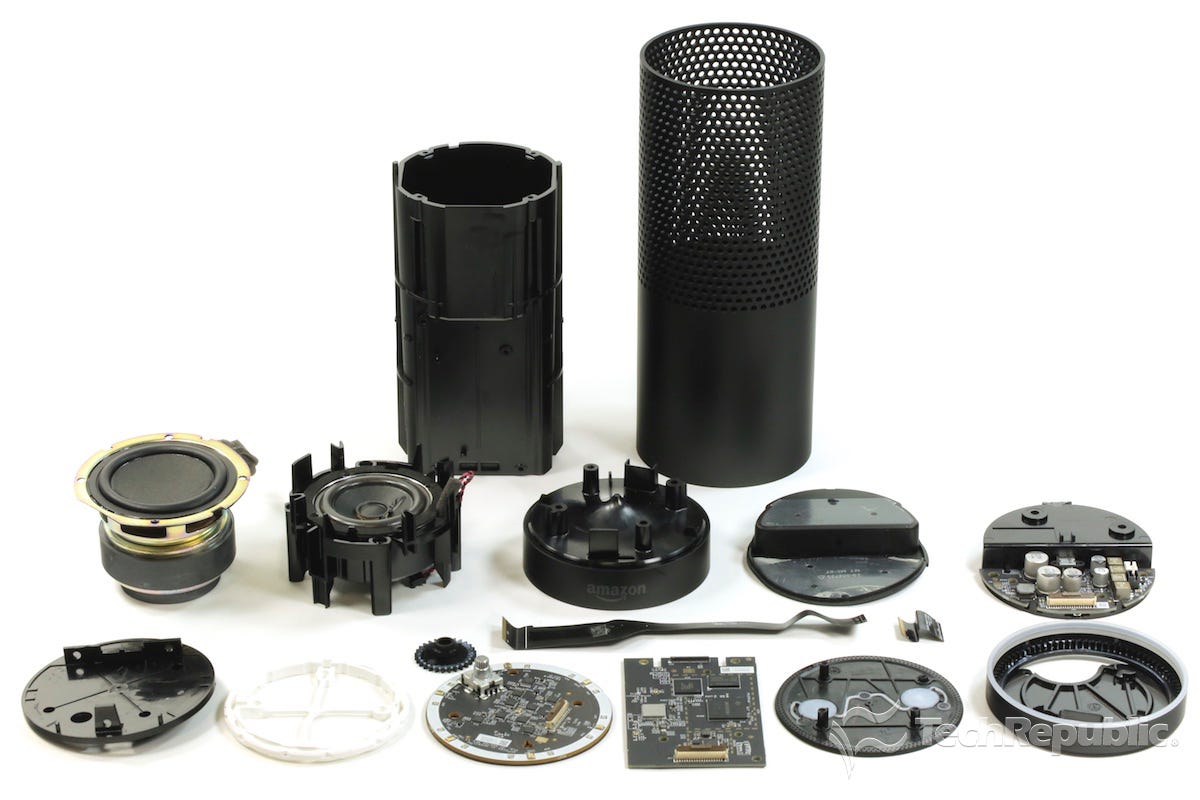

Now playing:
Watch this:
Cracking Open: Amazon Echo
5:04
Part speaker, part microphone, part “Star Trek” computer in your house, the Amazon Echo is a surprisingly handy “smart” appliance. But how did Amazon give an otherwise ordinary Bluetooth speaker a brain? To learn what really makes this speaker “smart,” we’ll need to crack it open.
The Echo is 9.25-inches tall and 3.27-inches wide, or about the size of a one-liter drink container. Its controls are minimal. There is a microphone on/off button and action button on the top, as well as a rotating volume ring. LEDs are located around the edge of the volume ring and under the buttons. A connector for the power cord is located on the bottom.
Note: In the video, I refer to the microphone on/off button as the “speaker on/off button” as pressing it prevents the Echo from listening to your conversations and responding to your requests, rending the entire speaker pretty much useless and essentially “off”.
From the outside, that’s really about all there is to see other than the numerous microphone and speaker holes in the Echo’s black plastic shell. Time to break out that screwdriver.
Disassembling the Amazon Echo
To get inside the Echo, I first removed the rubber base. Unfortunately, I used a bit too much force and tore it during the process. Luckily, it’s on the bottom and no one will notice the damage when I put the speaker back together.
Four screws hold the bottom cover in place. Once I removed them and disconnected a few cables, I could remove the cover, which also holds the power board. The lower speaker cover came off next, followed by the outer shell and a thin piece of fabric that sits behind the speaker holes.

Bill Detwiler/TechRepublic
With the outer shell removed, I got my first good look inside the Echo. On the bottom, is the 2-inch tweeter, followed by the 2.5-inch woofer. The system board is mounted to the side of the internal frame and air chamber. The volume ring assembly, which includes the microphones and control buttons, is located at the top.
Another set of four screws hold the tweeter in place, and after removing them, I lifted out both the tweeter and the subwoofer. After detaching a few cables and removing a few more screws, the system board came off next.


Bill Detwiler/TechRepublic
Lastly, I removed the volume ring assembly, which is made up of several layers of plastic sandwiched together. By separating these layers, I uncovered the microphone and control board.
On the top of the control board are the LEDs and contacts for the speaker on/off button and action buttons. On the underside of the board, I found the Echo’s microphones, lots more LEDs, LED drivers and audio processors, along with the volume wheel’s control mechanism.
At this point, our Echo was in pieces and the teardown was complete.


Bill Detwiler/TechRepublic
What the teardown tells us
After cracking open the Echo, I learned that there’s plenty of cool tech inside the case, such as the following:
- Texas Instruments DM3725 Digital Media Processor
- 250MB Samsung mobile DRAM
- 4GB Toshiba eMMC NAND flash storage chip
- Qualcomm QCA6234 Dual-Band 802.11n and Bluetooth 4.0 chip
- National Semiconductor (Texas Instruments) LP5523 Programmable LED Driver
- Texas Instruments TLV320ADC3101 low-power, stereo audio analog-to-digital converter (ADC)
- Texas Instruments TPS65910 integrated power-management IC
I also got a look at the speakers and air chambers that help it deliver decent sound, for a small Bluetooth speaker.
But did I find out what makes the Echo smart? Well, yes…and the answer is, as with most digital assistants such as Apple’s Siri, Microsoft’s Cortana or Google Now…it’s the cloud.
Ask the Echo a question or make a request, and the device sends a recording of your voice to a server sitting somewhere in a massive data center. The server analyzes that audio recording, determines an appropriate action and then tells your Echo how to respond. In essence the Echo is just the ears and mouth of Amazon’s Alexa Voice Service. Thus, it’s only as smart as that service is, which I would say is on par with most other digital assistants.
Where the Echo really shines however, is its always on capability. Day and night, it’s sitting there waiting for you to make a request. Yes this is a bit creepy, but it’s also incredibly useful.
Sure, I could take my iPhone out of my pocket, hold the Home button and ask Siri to do the same thing as the Echo. But that’s not as easy as walking into my kitchen and asking Alexa what the weather is, to turn on the news or set a timer so I don’t burn what I’m cooking.
Having used the Echo for several weeks, I found it be incredibly useful and as close to a “Star Trek” computer as any digital assistant I’ve tested. Now, if I could only get the Echo to wake up when I say “computer.”




